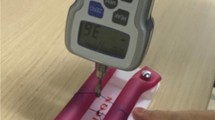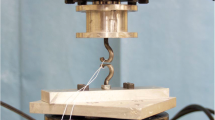Abstract
Background
The knot configurations used in clinical practice often are based on tradition and previous training. This study was designed to test the hypothesis that knot quality improves with the addition of a single throw in two-throw and three-throw knots. We tested this hypothesis by using commonly used knot configurations and suture materials.
Methods
Three suture materials, SURGIPRO, BIOSYN and POLYSORB, of 3-0 caliber were used. The break force and integrated force of each material, a single-hitch throw on each material, and 2160 knots of six configurations were measured by using tensiometry. The knot quality scores (KQS) of the different knot configurations were compared by using nonparametric tests.
Results
A single-hitch throw on the suture material reduced the break force by up to 40%. The addition of an extra throw improved KQS in 2 × 1 × 1, 2 × 2, and 2 × 2 × 1 knots. The four-throw knot configurations resulted in high KQS and low slippage rates. The 2 × 2 knots were most likely to slip and had the lowest KQS.
Conclusions
If a double-hitch throw is used in the first throw, two to three further throws are recommended. The four-throw knot configurations have the best knot qualities and should generally be used.



Similar content being viewed by others
References
Amortegui JD, Restrepo H (2002) Knot security in laparoscopic surgery. A comparative study with conventional knots. Surg Endosc 16:1598–1602
Hanna GB, Frank TG, Cuschieri A (1997) Objective assessment of endoscopic knot quality. Am J Surg 174:410–413
Ritter EM, McClusky DA 3rd, Gallagher AG et al (2005) Real-time objective assessment of knot quality with a portable tensiometer is superior to execution time for assessment of laparoscopic knot-tying performance. Surg Innov 12:233–237
Lee AC, Haddad MJ, Hanna GB (2007) Influence of instrument size on endoscopic task performance in pediatric intracorporeal knot tying. Surg Endosc 21:2086–2090
Emam TA, Frank TG, Hanna GB et al (1999) Rocker handle for endoscopic needle drivers. Technical and ergonomic evaluation by infrared motion analysis system. Surg Endosc 13:658–661
Van Sickle KR, Smith B, McClusky DA 3rd et al (2005) Evaluation of a tensiometer to provide objective feedback in knot-tying performance. Am Surg 71:1018–1023
Dinsmore RC (1995) Understanding surgical knot security: a proposal to standardize the literature. J Am Coll Surg 180:689–699
Brown RP (1992) Knotting technique and suture materials. Br J Surg 79:399–400
Kadirkamanathan SS, Shelton JC, Hepworth CC et al (1996) A comparison of the strength of knots tied by hand and at laparoscopy. J Am Coll Surg 182:46–54
Ivy JJ, Unger JB, Hurt J et al (2004) The effect of number of throws on knot security with nonidentical sliding knots. Am J Obstet Gynecol 191:1618–1620
Schubert DC, Unger JB, Mukherjee D et al (2002) Mechanical performance of knots using braided and monofilament absorbable sutures. Am J Obstet Gynecol 187:1438–1440
Nathanson LK, Nathanson PD, Cuschieri A (1991) Safety of vessel ligation in laparoscopic surgery. Endoscopy 23:206–209
Acknowledgement
The authors thank Covidien for sponsoring the suture materials used in this study.
Author information
Authors and Affiliations
Corresponding author
Rights and permissions
About this article
Cite this article
Lee, A.C.H., Fahmy, R.R.R. & Hanna, G.B. Objective Evidence for Optimum Knot Configuration. World J Surg 32, 2736–2741 (2008). https://doi.org/10.1007/s00268-008-9764-9
Published:
Issue Date:
DOI: https://doi.org/10.1007/s00268-008-9764-9




